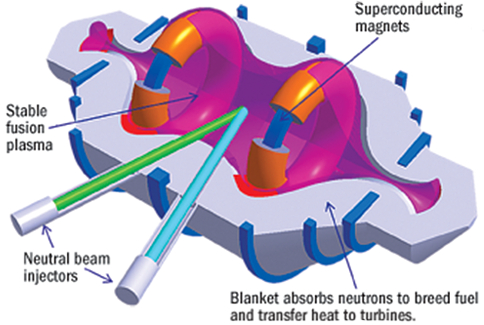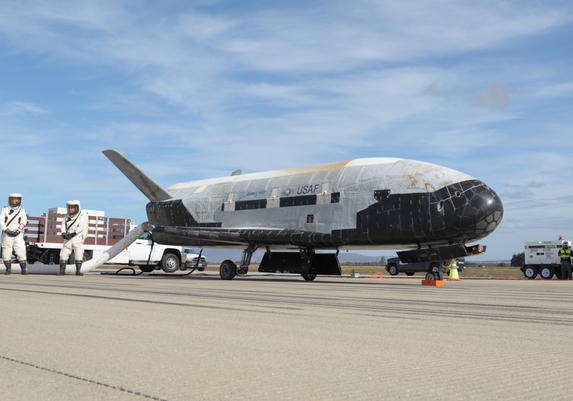
(Con)Fusion
Last week, I talked about researchers at Washington University who’ve been working toward a smaller kind of fusion reactor called a Spheromak reactor (check out their publication in the April 2014 issue of Fusion Engineering and Design for more). This week, Lockheed-Martin’s experimental production wing Skunkworks announced they’re working on something similar. Both are called “high-beta” designs, where beta is a variable from plasma physics that marks the ratio of the plasma pressure to the magnetic pressure. A high-beta reactor, then, has a compression field strength that just about matches its plasma’s outward pressure (where beta equals one), something that has been very hard to achieve in a traditional toroidal (tokamak) reactor shape (where the highest seen has been around 0.4). What does this mean? Well, let’s not get too excited.
At the beginning of the week, everyone had just seen this video, and nobody had talked to any physicists about it. And seriously, go watch it, I’ll wait.
Back? Great. It gives you a great warm and fuzzy feeling about the future of energy, right? So everyone’s seen this, and they’re all “Lockheed Martin’s new fusion reactor might change humanity forever.” But as the week went on, it became more like “So Lockheed Martin says it’s made a big advance in nuclear fusion…” (ellipsis of foreboding included). And now everyone’s like “Lockheed Martin says it’s a decade away from compact nuclear fusion. Here’s why you should be skeptical.”
Why? The TL;DR is that nobody’s turned the theory into a reality yet. It’s a very promising bit of theory, but there are some definite hitches. One major one is the problem of heat dissipation. According to one thermonuclear plasma physicist, “we know of no materials that would be able to handle anywhere near that amount of heat.” Another one is the one the folks at ITER aren’t even sure they’ll be able to surmount: efficiency. It takes so much energy to start a fusion reaction, that the “break-even” points are very hard to reach.
I’ve said it before and I’ll say it again: I’m thrilled people are working on fusion in a less-centralized, less-ITER way. When all you have to show for thirty years’ work is a (remarkable, high-tech, incredibly stable) concrete floor, your problem may not be the science. Here’s hoping that the small-scale, rapid-prototyping model helps spur on the development of the best hope for “free” energy for the future, and that fusion won’t always be the “energy of the future.”
Dark Matters (1): Less than we thought
In the first piece of news this week about dark matter, it turns out there’s less of it than we thought around the Milky Way, and that’s probably a good thing. New, more detailed estimates of the amount of dark matter around our home galaxy — made by very carefully observing the ways things move in the galaxy — have allowed us to shrink the amount of dark matter by about half. This is a good thing, because under old estimates, there was a problem called the “missing satellite problem.” Basically, the Milky Way only has three satellite galaxies: the Large and Small Magellanic Clouds and the Sagittarius Dwarf Galaxy. But with the mass of the dark matter previously predicted being so high, we should have seen far more. With the new estimates in place, there should only be three: exactly the number we see. Check out the October issue of The Astrophysical Journal for more.
Dark Matters (2): FUNK
A new experiment is underway to look for a theorized type of dark matter called “hidden photons” — which are just what they sound like: the dark matter equivalent of regular photons. A group of European researchers is making use of a spherical, metallic mirror to try to spot the elusive particles. The idea is that when the hidden photons hit the mirror, they should (weakly) interact with the electrons of the atoms making it up, causing regular old visible photons to shoot off perpendicular to the surface. A spherical mirror should therefore concentrate all of the emitted photons in the center of the curve. The real devil of the experiment will be isolating the mirror from all other possible sources of interference, so I won’t hold my breath just yet. Check out the article at Physics World for more.
Dark Matters (3): Axions
Scientists working out of the University of Leicester have spotted an unusual X-ray signal in space that may be the first hints of evidence of a kind of theorized dark matter called “axions.” The team, led by the late Professor George Fraser, combed through fifteen years of data from the European Space Agency’s XMM-Newton observatory, and found a signal that would be the same as if axions, being produced in the sun, were being converted to X-rays in the Earth’s atmosphere. It’s still early days, but if it pans out, it could be the beginning of real results in our search for just what cold dark matter is really made of. Check out the explainer at io9, or the preprint of the article over at arXiv.org.

The Return of the X37-B
After twenty-two months in space, the US Air Force’s unmanned “space drone” the X37-B has landed safely at Vandenberg Air Force Base in California. What was it up there for so long for? Nobody knows. That’s pretty much the reason everyone’s talking about it. They couldn’t have gotten more coverage if they were a popular underground musician releasing their first album in fourteen years directly to the darkweb. But here’s what we do know: it didn’t destroy any other satellites while in orbit (at least, not in a way that left any debris — anyone’s old satellites suddenly get EMP’d? Anyone?), it didn’t make any extremely suspicious maneuvers. It didn’t go far enough north to spy on Russia or Ukraine. And it did stay up there for pretty much longer than anything we’ve ever sent up and still wanted back in one piece. Oh, and if you think the guys in hazmat suits are indicative of anything secret, sorry: the fuel the little critter uses is hydrazine, and that stuff is worth wearing a hazmat suit over. For more pictures, check out space.com. If nothing else, it’s a cute little space place.
Surgery Without Blood Thinners?
Imagine you had to keep someone’s blood oxygenated for a few hours while you stopped their hearts. You’d need a tube out of their body, a machine to oxygenate the blood and keep it moving, and another tube back in. All that moving about and bumping into things, and the blood starts to think “hey, this is an injury site” and starts forming clots. Without blood thinners, cardiovascular surgery is pretty much impossible. But now, a team of researchers at Harvard may have come up with another solution: non-stick everything. The best part? It’s all materials that have been cleared for medical use already, just new surface textures and assembly methods that allow the blood to flow through without any of it stopping or getting caught and clotting. While still in early stages of testing, if the idea works, it could make surgery a lot less dangerous. Check out phys.org for more.
HBO sans Cable
What kind of a science and technology blog would this be if we didn’t at least nod in the direction of HBO’s latest news? The media giant and producer of some of the better television programs available today (Game of Thrones, True Detective, Boardwalk Empire) has finally decided to join the 21st century and allow customers to watch their shows without a cable subscription. It’ll probably cost you around what your hulu or netflix monthly fees are (which, at least last time I checked, got more than ten shows each, but who’s counting, right?) but if you just can’t live without it, now you can do it legally. Aren’t you happy?
Best of the Rest
There were some other stories this week. Let’s see what’s in the bag: a SSL vulnerability called POODLE was demonstrated, meaning you should probably be careful when using a public Wi-Fi network; Wired took a lot of nice pictures of the biggest ship in the world, the Matz Maersk Triple E; Apple released a new OSX (10.10 Yosemite), and I’m sure it’s totally fine; the ISS has way more science than it has time to actually do; Kawasaki made a 300-hp bike for insane people; MAVEN sent back its first images of the Martian atmosphere; and Dyson released its yearly competition’s shortlist of finalists (me, I think the Sit-Stand Wheelchair is a shoe-in, but we’ll find out November 6).
Anyway, that’s all we’ve got for today. Thanks for reading, and have a great week.
